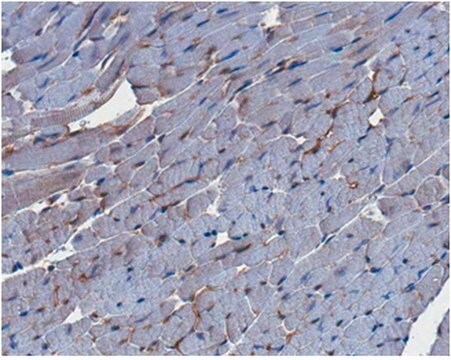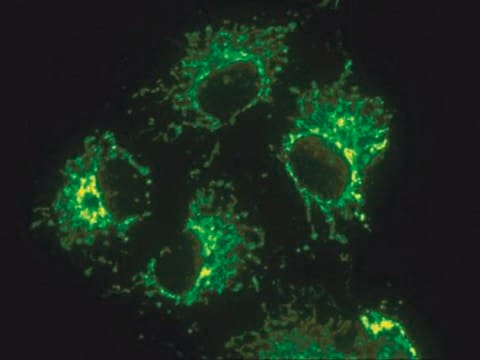MABS1273
Anti-Thrombomodulin Antibody, clone 411-201B
clone 411-201B, from rat
Sinonimo/i:
Thrombomodulin, CD141, Fetomodulin, SnoRNA MBII-339, TM
About This Item
Prodotti consigliati
Origine biologica
rat
Livello qualitativo
Forma dell’anticorpo
purified immunoglobulin
Tipo di anticorpo
primary antibodies
Clone
411-201B, monoclonal
Reattività contro le specie
human, mouse
tecniche
ELISA: suitable
electron microscopy: suitable
immunohistochemistry: suitable (paraffin)
immunoprecipitation (IP): suitable
western blot: suitable
Isotipo
IgG2aκ
N° accesso NCBI
N° accesso UniProt
Condizioni di spedizione
wet ice
modifica post-traduzionali bersaglio
unmodified
Informazioni sul gene
human ... THBD(7056)
Descrizione generale
Immunogeno
Applicazioni
Electron Microscopy: A representative lot detected thrombomodulin immunoreactivity associated with capillary endothelial cells by EM using frozen mouse lung sections (Kennel, S.J., et al. (1988). Lab. Invest. 59(5):692-701).
Immunoprecipitation Analysis: A representative lot immunoprecipitated the 112 kDa thrombomodulin from normal mouse lung fibroblast (NMLF) lysates, but not from thrombomodulin-depleted NMLF lysates by performing IP with clone 273-34A (Cat. No. MABS1245) prior to IP with clone 411-201B (Kennel, S.J., et al. (1988). Lab. Invest. 59(5):692-701).
Western Blotting Analysis: A representative lot detected thrombomodulin (P112) in the normal mouse lung fibroblast (NMLF) immunoprecipitates obtained with either clone 411-201B or clone 273-34A (Cat. No. MABS1245) (Kennel, S.J., et al. (1988). Lab. Invest. 59(5):692-701).
Immunohistochemistry Analysis: Representative lots and clone 273-34A (Cat. No. MABS1245) showed similar staining pattern using both frozen and paraffin-embedded mouse lung sections (Ford, V.A., et al. (1992). J. Biol. Chem. 267(8):5446-5450; Rorvik, M.C., et al. (1988). J. Histochem. Cytochem. 36(7):741-749; Kennel, S.J., et al. (1988). Lab. Invest. 59(5):692-701).
ELISA Analysis: Representative lots were used as the detection antibody for the detection of thrombomodulin in mouse tissue samples by sandwich ELISA using clone 273-34A (Cat. No. MABS1245) as the capture antibody and an HRP-conjugated secondary antibody, or by sandwich radio-immunoassay employing 125I-labeled clone 411-201B without an enzyme-conjugated secondary antibody (Isermann, B., et al. (2001). Development. 128(6):827-838; Conway, E.M., et al. (1999). Blood. 93(10):3442-3450; Weiler-Guettler, H., et al. (1996). Circ. Res. 78(2):180-187; Ford, V.A., et al. (1992). J. Biol. Chem. 267(8):5446-5450).
Signaling
Immunoglobulins & Immunology
Qualità
Immunohistochemistry Analysis: A 1:1,000 dilution of this antibody detected Thrombomodulin in mouse lung tissue.
Descrizione del bersaglio
Stato fisico
Stoccaggio e stabilità
Altre note
Esclusione di responsabilità
Non trovi il prodotto giusto?
Prova il nostro Motore di ricerca dei prodotti.
Codice della classe di stoccaggio
12 - Non Combustible Liquids
Classe di pericolosità dell'acqua (WGK)
WGK 1
Punto d’infiammabilità (°F)
Not applicable
Punto d’infiammabilità (°C)
Not applicable
Certificati d'analisi (COA)
Cerca il Certificati d'analisi (COA) digitando il numero di lotto/batch corrispondente. I numeri di lotto o di batch sono stampati sull'etichetta dei prodotti dopo la parola ‘Lotto’ o ‘Batch’.
Possiedi già questo prodotto?
I documenti relativi ai prodotti acquistati recentemente sono disponibili nell’Archivio dei documenti.
Il team dei nostri ricercatori vanta grande esperienza in tutte le aree della ricerca quali Life Science, scienza dei materiali, sintesi chimica, cromatografia, discipline analitiche, ecc..
Contatta l'Assistenza Tecnica.







